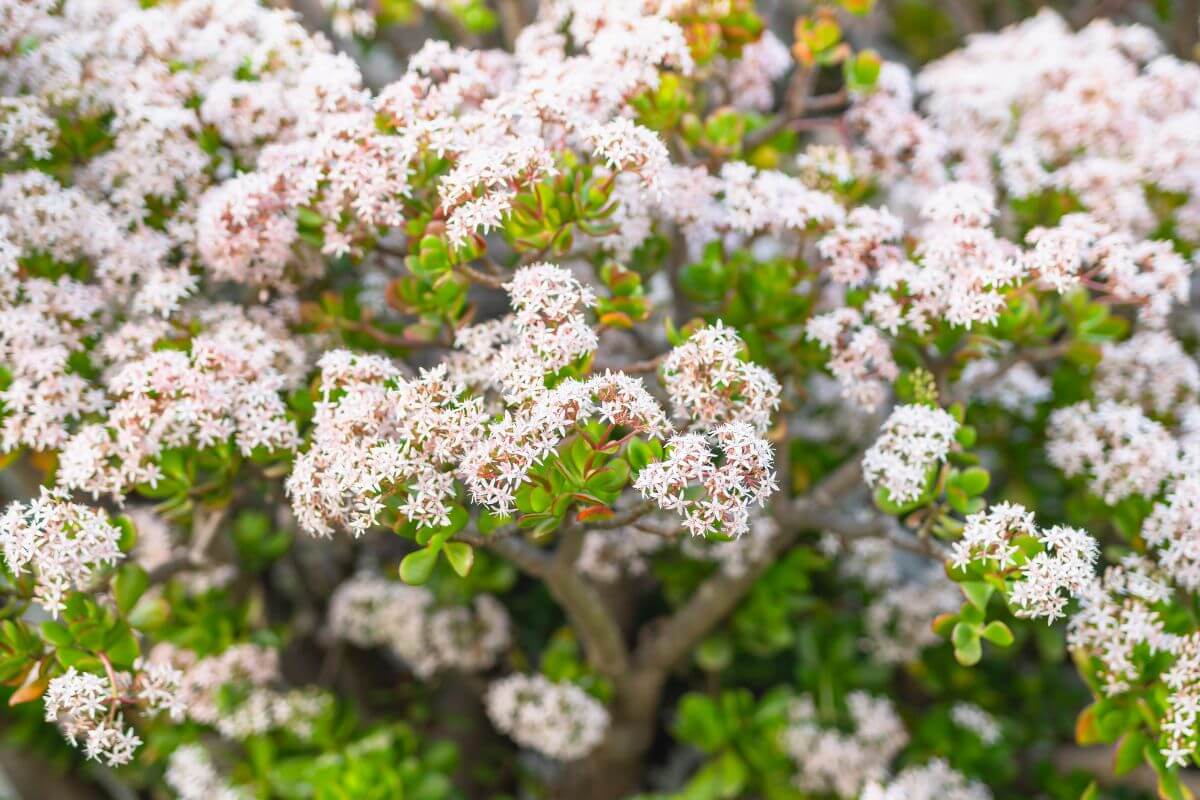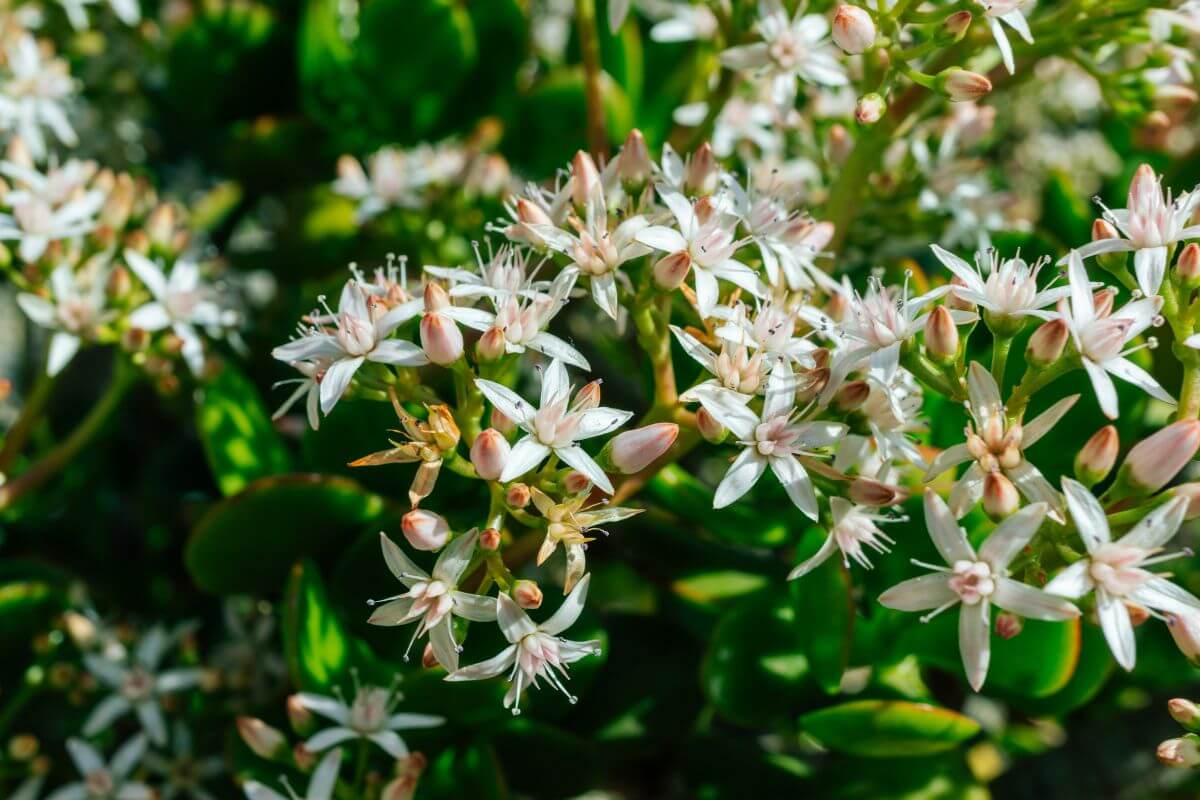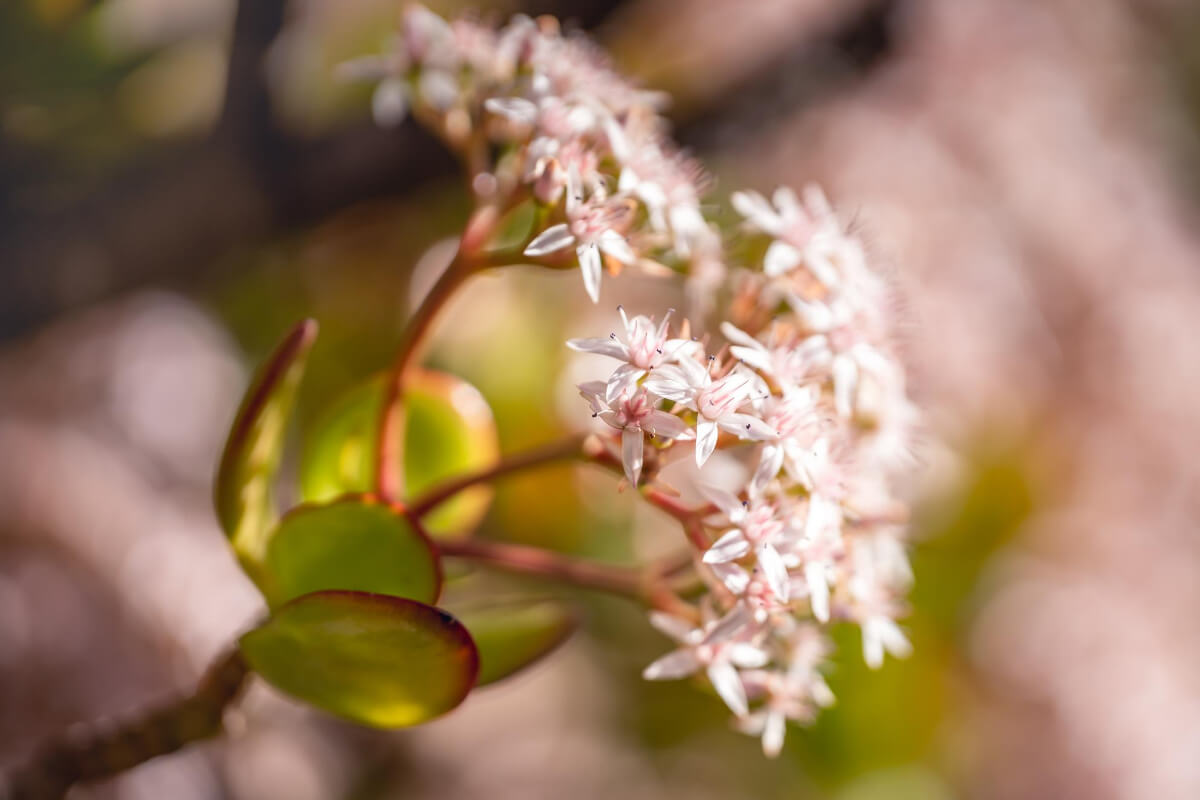Does a Jade plant bloom? Will indoor Jade plants bloom? Yes they do and yes they will!
Let’s take a look at Jade flowering and how to get your jade plant to bloom.
The Jade plant is a popular and easy-to-care-for houseplant, while also being an attractive succulent. It’s a wonderful choice to include in any home garden, whether indoor or outdoor.
Getting your Jade plant to bloom can be very difficult, especially for indoor plants. Don’t lose hope if you are initially unsuccessful.
If you are intent on having your Jade plant bloom, provide a desert-like environment that is arid, hot, and sunny. Nights need to be cooler, and watering should be reduced significantly. Unfortunately, this type of environment is not typically found in indoor settings.
- Related article: Jade Plant Care Indoors
Does a Jade Plant Bloom?

Indeed, it does! While Jade plants are famous for their fleshy, glossy foliage, these succulents can blossom and produce seeds.
The Jade plant is also known as the Lucky plant or Money plant. The most popular Jade plant found in home gardens is the Crassula Ovata. It generally reproduces through offsets and vegetative processes. But this plant can and does bloom.
Blossoming requires reproducing the plant’s ideal growing conditions in its native habitat. Bright sunshine, cool nights, and little water will encourage a Jade plant to flower.
A Jade plant, even in its natural habitat, must be quite mature to produce blooms. Ideally, the environment needs to be arid, and this is one of the first impediments to indoor cultivation.
Many indoor locations are simply too humid to stimulate the formation of buds. Your Jade plant will be more likely to flower if humidity measures between 30% and 50%.
How to Get a Jade Plant to Flower?
The Jade plant must have the same environment as found in its natural habitat. In cold areas, it will not flower.
As a native of South Africa, and Mozambique, this succulent plant relies on extremely hot temperatures and very little rainfall. If your area does not mimic this type of climate, it can still be healthy, but it will not produce blossoms.
Coaxing your Jade plant to flower requires a spot in a very dry location. You also need to reduce watering if not withhold it altogether. Your plant needs to be in a room or location where nighttime temperatures drop and are cooler.
The Jade plant needs both rest and a sunny period to remain healthy, bloom, and reproduce. This plant does not enter dormancy, but does need to rest period before the bloom-producing period.
During fall and early winter, as days shorten, interrupt any fertilization, and reduce watering. During this period, the Jade plant needs to have an environmental temperature of approximately 60°F. It will need to be protected from frost and freezing temperatures.
The buds and blossoms covered in pink sepals will begin to form during the year’s shortest days. Expect blooming to begin at the end of winter and in early spring.
Small white and star-shaped pink flowers are produced in a cluster formation on branch tips. They live for a very short time. Some may last a few weeks while others will last only a few days. Once flowers are spent and the stem turns brown, trim off all flowering stalks. At this point, increase watering.
Temperatures should increase as the spring season progresses. In the summer, move indoor plants outside to a location with partial shade from harsh sun and UV rays. Sunlight encourages plants to bloom.
A Jade plant does require at least 6 hours daily of bright natural sunlight even if indirect.
When the soil bed dries out, water your plant. The Jade plant enjoys a little crowding in its container so it will not require repotting very often. It will need new soil approximately every 3 years.
Jade plant repotting should always be carried out after blooming and preferably a month or so before moving an indoor plant outside.
The plant also must be an older Jade plant, as younger species will not flower. Keep this in mind if you have reproduced the ideal environmental conditions for flowering. If your plant still does not bloom, it simply may be too young for reproduction.
Indoor or Outdoor Jade Cultivation for Flowering?
Jade plants require lots of very bright indirect sunlight to flower.
Generally speaking, it is very difficult to meet this requirement when cultivating a plant indoors. Indoor alternatives may include a sunroom, a conservatory, or a south-facing window.
Consider that an indoor Jade plant will probably require more than the 6 hours recommended for outdoor Jade plants as light may not be as bright. When placed in a window, your plant will need a window that has direct sunlight for 8 to 12 hours if possible.
The best option for getting a habitually indoor Jade plant to blossom is to place it outside for a portion of the year.
If Jade plant foliage achieves a red hue, you are definitely working in the right direction for flowering. Hot, bright light causes anthocyanin formation in leaf tips, and they turn red. The longer the sunlight exposition is, the redder the hue.
If you are cultivating an indoor Jade plant, place it outside in a sunny spot during the spring and summer seasons to encourage blooming.
The ideal Jade plant environment needs to provide hot, bright, sunny days with very little humidity, and cool evenings and nights. You may be able to achieve this in the winter if you use indoor heating.
Providing humidity is always a problem in a heated home or office. If your indoor location is well heated during the day with reduced humidity, and cooler at night, this is a great start.
The remaining problem is light. While doubtful that seasonal outdoor light will be significant, grow lights are a viable alternative.
If you can find a grow light to satisfy light needs, you may get your indoor plant to bloom.
Consider that Jade plants cultivated outside will need to be grown in USDA hardiness zones 10 and 11. Plants cultivated outdoors in other zones are unlikely to flower.
What Does It Mean When a Jade Plant Flowers?
The tradition of Feng Shui draws parallels with nature and human life. For Feng Shui, the Jade plant represents prosperity and good fortune.
In Asia, the Jade plant is very popular where it is considered a “money tree” and is gifted as a housewarming or business gift. It is often found at the entrances of businesses to attract success and prosperity.
Consequently, the flowering Jade plant reflects well on its owner. It represents fortune, prosperity, and friendship.
The fleshy green leaves represent nourishing positive energy. Flowers are considered to emit the fragrance of friendship.
How Often Do Jade Plants Flower?

Most flowering houseplants will bloom a minimum of once annually.
Jade plants are not most houseplants. They feature an irregular flowering pattern. They may bloom one year, and not bloom the following year.
Some mature plants will bloom annually while others may grow for 10 years or so before blooming for the first time.
The Jade plant needs a relatively long period to store sufficient energy to support flowering. Blooms last for a very short period, and this plant does not need flowering to reproduce.
How Old Do Jade Plants Have to Be to Flower?
To be able to flower, a Jade plant must be mature. Young Jade plants do not flower.
The first years of life are dedicated to establishing root systems and growing. The minimum age for a flowering Jade plant will be 3 to 4 years old.
If your plant is small, be patient when expecting it to flower.
Should I Remove Flowers from Jade Plants?

Jade plant flowers last as little as a couple of days or as long as several weeks.
For spent flowers, deadheading or pruning is a common practice. It is not mandatory as spent flowers will eventually drop off on their own. Snipping off spent blooms, however, will in no way harm the plant.
There are several advantages to trimming off spent flowers. Plants dedicate lots of energy to produce blooms and even more energy to seed production.
In the case of the Jade plant, this is not necessary. Stem cuttings are much faster and more successful as a method of Jade plant propagation.
By removing spent blooms, your plant will save the energy not used in seed production. Jade seeds in nature will be distributed thanks to the wind.
For those interested in harvesting their own seeds, these can be collected once all of the plant’s blossoms have dried up completely. This energy will be used for growth and foliage production.
Another advantage to removal is not having your Jade bush covered in brown bits. The only difference is that when spent flowers fall off by themselves, they do not leave the small stubs typically left during trimming.
Once your Jade plant has completed its flowering, remove all of the spent blooms. Continue with normal Jade plant care.
Jade Flowering Final Thoughts
With some maneuvering and attention to detail, you can encourage your Jade plant to bloom. A properly cared Jade plant typically blooms in the late winter or early spring. In any case, Jade plant flowering will provide the ultimate and ongoing home gardening challenge.
Learn more about Jade plants and caring for them:

